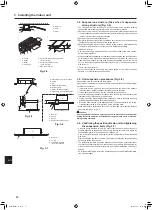
2
en
1.1. Before installation (Environment)
Caution:
• Do not use the unit in an unusual environment. If the air conditioner is
installed in areas exposed to steam, volatile oil (including machine oil), or
sulfuric gas, areas exposed to high salt content such as the seaside, the
performance can be significantly reduced and the internal parts can be
damaged.
• Do not install the unit where combustible gases may leak, be produced,
flow, or accumulate. If combustible gas accumulates around the unit, fire
or explosion may result.
• Do not keep food, plants, caged pets, artwork, or precision instruments in
the direct airflow of the indoor unit or too close to the unit, as these items
can be damaged by temperature changes or dripping water.
• When the room humidity exceeds 80% or when the drainpipe is clogged,
water may drip from the indoor unit. Do not install the indoor unit where
such dripping can cause damage.
• When installing the unit in a hospital or communications office, be prepared
for noise and electronic interference. Inverters, home appliances, high-
frequency medical equipment, and radio communications equipment can
cause the air conditioner to malfunction or breakdown. The air conditioner
may also affect medical equipment, disturbing medical care, and communi-
cations equipment, harming the screen display quality.
1.2. Before installation or relocation
Caution:
• Be extremely careful when transporting the units. Two or more persons
are needed to handle the unit, as it weighs 20 kg or more. Do not grasp the
packaging bands. Wear protective gloves as you can injure your hands on
the fins or other parts.
• Be sure to safely dispose of the packaging materials. Packaging materials,
such as nails and other metal or wooden parts may cause stabs or other
injuries.
• Thermal insulation of the refrigerant pipe is necessary to prevent conden-
sation. If the refrigerant pipe is not properly insulated, condensation will be
formed.
• Place thermal insulation on the pipes to prevent condensation. If the drain-
pipe is installed incorrectly, water leakage and damage to the ceiling, floor,
furniture, or other possessions may result.
• Do not clean the air conditioner unit with water. Electric shock may result.
• Tighten all flare nuts to specification using a torque wrench. If tightened
too much, the flare nut can break after an extended period.
• If the unit is run for long hours when the air above the ceiling is at high
temperature/high humidity (dew point above 26 ºC), dew condensation may
be produced in the indoor unit or the ceiling materials. When operating the
units in this condition, add insulation material (10-20 mm) to the entire sur-
face of the unit and ceiling materials to avoid dew condensation.
1.3. Before electric work
Caution:
• Be sure to install circuit breakers. If not installed, electric shock may result.
• For the power lines, use standard cables of sufficient capacity. Otherwise,
a short circuit, overheating, or fire may result.
• When installing the power lines, do not apply tension to the cables.
• Be sure to ground the unit. If the unit is not properly grounded, electric
shock may result.
• Use circuit breakers (ground fault interrupter, isolating switch (+B fuse),
and molded case circuit breaker) with the specified capacity. If the circuit
breaker capacity is larger than the specified capacity, breakdown or fire
may result.
1.4. Before starting the test run
Caution:
• Turn on the main power switch more than 12 hours before starting opera-
tion. Starting operation just after turning on the power switch can severely
damage the internal parts.
• Before starting operation, check that all panels, guards and other protec-
tive parts are correctly installed. Rotating, hot, or high voltage parts can
cause injuries.
• Do not operate the air conditioner without the air filter set in place. If the air
filter is not installed, dust may accumulate and breakdown may result.
• Do not touch any switch with wet hands. Electric shock may result.
• Do not touch the refrigerant pipes during and immediately after operation.
• After stopping operation, be sure to wait at least five minutes before turn-
ing off the main power switch. Otherwise, water leakage or breakdown may
result.
2. Installation location
Refer to the outdoor unit installation manual.
3.1. Check the indoor unit accessories (Fig. 3-1)
The indoor unit should be supplied with the following accessories.
Accessory name
Q'ty
1
Installation template (top of the package)
1
2
Washers (with insulation)
Washers (without insulation)
4
4
3
Pipe cover (for refrigerant piping joint)
Small diameter
Large diameter
1
1
4
Band (large)
8
5
Band (small)
1
6
Drain socket
1
7
Insulation
1
Fig. 3-1
1
2
3
4
5
6
7
3. Installing the indoor unit
1. Safety precautions
RG79F456H01_en.indd 2
2019/07/03 14:25:25
004
004





































